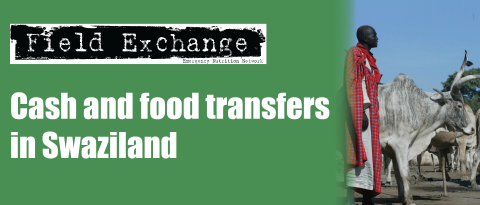Comment on: Putting IFE guidance into practice: operational challenges in Myanmar
By UNICEF Myanmar
As reflected in the field article by Save the Children, there were many elements to coordinating a response on infant and young child feeding (IFE) during cyclone Nargis. These involved collaboration with the government and Ministry of Health (MOH), the assistance of other clusters, and the support of NGOs with technical expertise. Here we share our perspective of the IFE response.
Coordination
The Nutrition Cluster response was established on 7th May 2009. UNICEF, as the cluster lead agency, initiated, supported, assisted, coordinated and implemented all emergency nutrition activities, including IFE, in the cyclone Nargis response. The Nutrition Cluster had three working groups: Therapeutic and Supplementary Feeding WG, IFE WG and Surveillance WG. UNICEF was identified as lead for the Therapeutic and Supplementary Feeding WG. Save the Children as lead organisation for the IFE WG with support from UNICEF, as per agreement of the Myanmar Nutrition Cluster members.
After cyclone Nargis, the Nutrition Cluster, led by UNICEF, responded promptly and effectively to IFE and issues around BMS use, as reflected in the activities we undertook in collaboration with many partners:
- UNICEF developed a breastfeeding leaflet during the first week of cyclone Nargis, distributed to cluster members on 7th May 2008.
- UNICEF, with cluster members, translated, produced and widely disseminated IEC materials, along with a number of relevant statements and documents on optimal infant feeding practices. The documents included a Joint Statement on IFE (English and Myanmar versions), Infant and Young Child Feeding in Emergency Operational Guidance for emergency relief staff and programme managers (Myanmar version), and 'Protecting Infants in Emergencies: information for the Media'1. UNICEF advocated and circulated these documents to the MOH, including basic health staff, to nutrition cluster members, other relevant agencies and NGOs, in conjunction with a press release.
- The Joint Statement on IFE was endorsed by UNICEF, WHO, Save the Children, ACF, Merlin, ICRC and IFRC and circulated to the Food Cluster on the 9th June, Protection Cluster on the 11th June and Health Cluster during June 2008. It was widely shared, especially during breastfeeding week, and dissemination included an orientation workshop for local media accompanied by advisory notes.
- The Nutrition Cluster officially requested the Logistics Cluster not to accept any milk powder or infant formula or any BMS. As a result, the Logistics Cluster ceased the importation of BMS from the Bangkok hub into Myanmar. UNICEF field staff continued to monitor the situation, along with basic health staff. Since the Post Nargis Joint Assessment (PONJA) was conducted, there were few donations of milk powder or feeding bottles witnessed.
These efforts had been regularly reported by the IFE WG, chaired by Save the Children.
Rapid Assessment and Survey
There was a variety of rapid assessment tools used immediately after the cyclone. One of the tools was the 'multi-sectoral initial rapid assessment (IRA) tool' developed by the Global Nutrition Cluster that includes infant and young child feeding indicators. It was used for data collection for the PONJA and Save the Children participated in and helped finalise the questionnaires.
Linkage between Community and Facility Based Management of Acute Malnutrition
The Nutrition Cluster initiated and implemented community-based management of acute malnutrition (CMAM) in 12 highly affected townships. For severely acutely malnourished children with complications, UNICEF, in collaboration with the Department of Health, strengthened and established 12 hospital nutrition units in the cyclone Nargis areas within a few weeks of the cyclone.
Collaboration between the Nutrition Cluster and other clusters
UNICEF recognised the acute needs of children under five years and pregnant and lactating women during this emergency. Food vouchers and complementary food baskets were the domain of WFP and Food Cluster. On 6th June 2008, the Nutrition Cluster issued guidance on 'Blanket Feeding with BP5 for all 6-59 months children, pregnant and lactating women (PLW) and other vulnerable groups'. On 10 June 2008, the cluster issued 'Recommendations for Supplementary Feeding'. It included adding energy to the food basket/ration for children and mothers and provision of targeted supplementary feeding in areas where this was feasible.
The Food Cluster agreed to provide a one month blanket supplementary feeding with BP5 for all under five children and PLW in July/August 2008 in four highly affected townships. The Nutrition Cluster, via the Therapeutic and Supplementary Feeding WG, discussed supplementary feeding with partners and WFP. This led to WFP provision of fortified blended food to all PLW (together with children) in seven townships, starting from October 2008 and following the one month blanket feeding. (This is still continuing in two townships at present).
Emergency preparedness and early response
The Nutrition Cluster was one of the clusters in Myanmar that had developed a Contingency Plan before the cyclone hit. Immediate responses to cyclone Nargis were based on the draft plan laid down in April 2008, which included "support of infant and young child feeding" in operational objectives, "supporting breastfeeding, food assistance for pregnant and lactating women, working with breastmilk substitutes (BMS)", and "support for breastfeeding and relactation" as one of the immediate responses.
Preparedness activities facilitated a rapid response on IFE. In the first weeks of the response, an interagency joint statement on IFE, standard media messages and pamphlets to advocate exclusive breastfeeding were distributed widely, while a media roundtable discussion was convened by UNICEF. Awareness within the Ministry, clusters, and amongst basic health staff, nongovernmental organisations (NGOs) and the community was increased by the actions of UNICEF and its partners.
Cluster meetings minutes are available in http://myanmar.humanitarianinfo.org/nutrition/default.aspx
1Available in Resource Library at www.ennonline.net
Imported from FEX website

